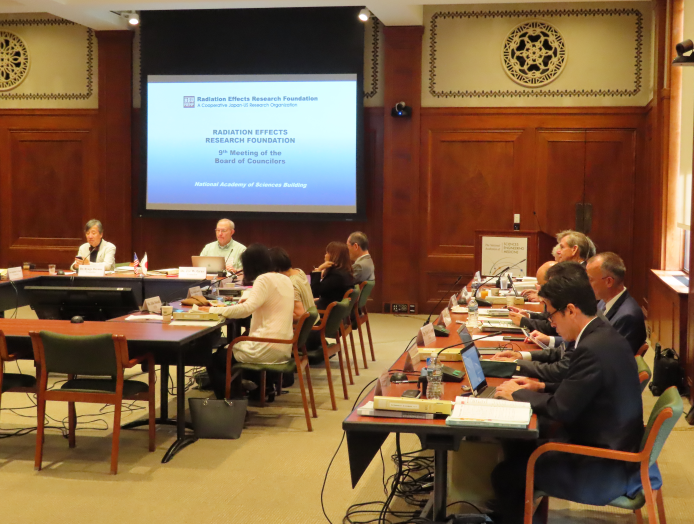- News
Summary Report of the Ninth Meeting of the RERF Board of Councilors
The ninth meeting of the RERF Board of Councilors (BOC)* was held in Washington, D.C., at the U.S. National Academy of Sciences June 20–21, 2019.
The main agenda items and results of the discussions are summarized below:
- I. Reports of activities and settlement of accounts
- A status report of activities in FY2018 was made based on the activities report, settlement of accounts report, audit report, and supporting documents. Deliberations that followed resulted in approval of these reports. In addition, a report was made on the results of an investigation into relocation of the Hiroshima RERF Laboratory.
- II. Activity plans, budget, and related matters
- Reports of FY2019 activity plans included research projects on the health of A-bomb survivors, the health of A-bomb survivors’ children (F1), and the elucidation of radiation doses in individuals from the atomic bombings and their effects. Also included were projects to publicize research results and collaborate with other scientific research institutions, training programs for domestic and overseas specialists, public information programs, and the FY2019 working budget required to implement these projects.
- III. Recommendations made by Scientific Advisory Committee and RERF’s responses
- At the 46th meeting of the Scientific Advisory Committee (SAC) held in Hiroshima March 22-24, 2019, SAC reviews focused on the Department of Molecular Biosciences and the Biosample Research Center, which will play an important role in the establishment of the “Research Resource Center.” The SAC Co-chairperson was present at the BOC meeting and reported that body’s recommendations for achieving success in RERF’s research projects. The BOC reviewed RERF’s responses to these recommendations.
- IV. RERF’s strategic plans
- The BOC discussed RERF’s reports on its mid- and long-term strategic plans and the Stakeholder Committee on Usage of A-bomb Survivors’ Biosamples.
- V. Appointment of management
- In the BOC meeting, the appointments of three RERF Directors, four Councilors, two Scientific Advisors, and two Local Advisors were unanimously approved.
*Boards of Councilors are the highest decision-making bodies of public interest foundations. RERF’s BOC determines the structure for work execution (e.g., appointments and dismissals of directors, auditors, and others) and the basic rules for foundation management (changes to the Articles of Incorporation, etc.). Through approval of financial statements, the BOC monitors whether RERF management is undertaken in accordance with laws and ordinances as well as the RERF Articles of Incorporation.
Participants of this year’s Board of Councilors meeting were as follows:
COUNCILORS
- Dr. Ryugo Hayano
- Emeritus Professor, The University of Tokyo
- Dr. Joe W. Gray
- Professor and Gordon Moore Endowed Chair, Department of Biomedical Engineering, School of Medicine, Oregon Health & Science University
- Dr. Shelley A. Hearne
- Executive Director, Forsythia Foundation and Visiting Professor, Department of Health Policy and Management, Johns Hopkins Bloomberg School of Public Health
- Mr. Masaaki Kuniyasu
- Former Ambassador Extraordinary and Plenipotentiary to Sri Lanka, the Republic of Portugal, and other nations
- Dr. Jonathan M. Samet
- Dean, School of Public Health, University of Colorado
- Dr. Yoshiharu Yonekura
- Senior Advisor, National Institutes for Quantum and Radiological Science and Technology
DIRECTORS
- Dr. Ohtsura Niwa
- Chairman/Representative Director
- Dr. Robert L. Ullrich
- Vice Chairman and Executive Director
- Dr. Kazunori Kodama
- Executive Director
AUDITORS
- Mr. Takashi Kohno
- Certified Public Accountant and Tax Accountant, Hiroshima All-In Law and Accounting Office
- Mr. Paul Thrasher
- Certified Public Accountant/Financial Consultant
CO-CHAIRPERSON OF THE SCIENTIFIC ADVISORY COMMITTEE
- Dr. Curtis C. Harris
- Chief, Laboratory of Human Carcinogenesis, and Head, Molecular Genetics and Carcinogenesis Section, Center for Cancer Research, National Cancer Institute, National Institute of Health

BOC members outside the NAS building, which served as the meeting venue

A look at the meeting’s deliberations
